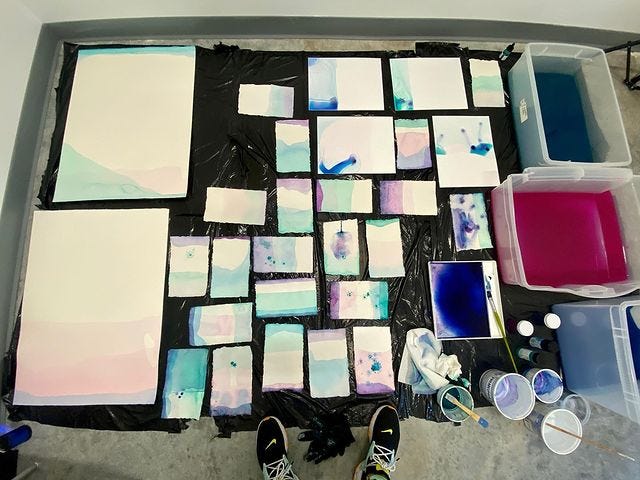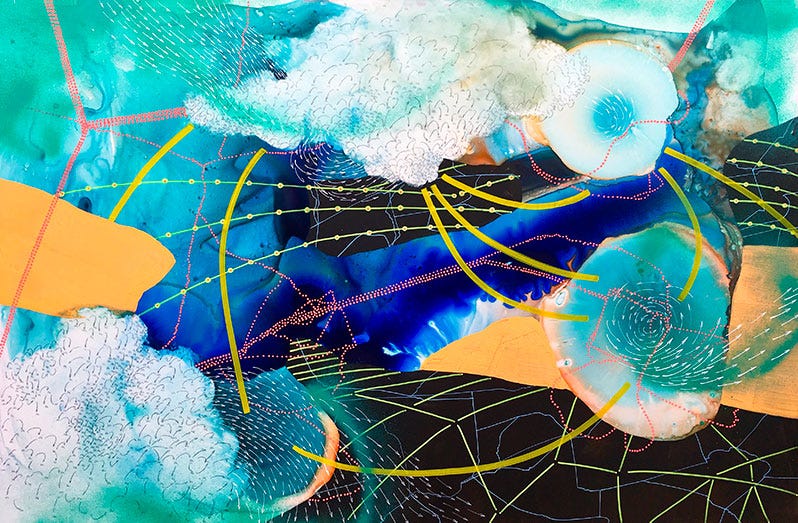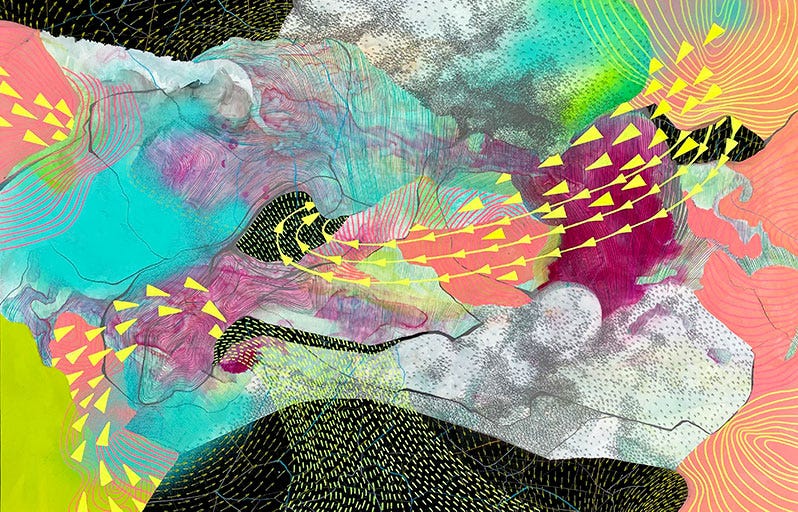Lost in Kalina Winska’s ‘Atmospheric Gaze’
Seattle-based, Polish artist goes to great, layered lengths to capture the effects of climate change through ‘audacious’ mixed media — colors, graphics, and poetic intuition
Kalina Wińska has a special way with layers upon layers of “audacious” colors, graphics, and oftentimes, textures, at her command. The young, Seattle-based, Polish mixed-media artist seems driven in turns by environmental concerns and a natural restlessness born to such noble, imaginative missions…
…to compel the average onlooker to do more than stare at blankly at a blank screen come to life.
Hers is a mission of sharing. When successful, the onlooker ascends the linear, map-like path of the artful canvas — much like the wind-swept clouds Wińska attempts to capture in acrylics and watercolors on canvas, wood panels, and special paper — into Narnia territory, where creatures great and small, alive and extinct, shimmy just beneath the surface.
Magic.
Her artwork appears to be a topographical weather map, with squiggly lines, dashes, and arrows, where currents ebb and flow — from the vantage point of a floating, circling satellite. Much of the atmospheric art is intentionally set, layer by layer, with the aim of conveying movement within the tools of weather technology: Doppler radar, AWIPS (NOAA’s Advanced Weather Information Processing System), and satellite data.
Stare long enough at her Unaccustomed Land series in acrylic paint, ink, and gouache on Yupo paper, and you’d swear there’s more going on than the inference of clouds over land masses.
There’s a water buffalo, a toucan, and an African bush elephant traversing the landscape, as Arctic glaciers crest and melt…heart-tugging, dramatic signs of the existence of man-made climate change and its disastrous effects on the animal kingdom facing greater and greater extinction.
Visit Edmonds featured the charming artist recently in “Ah, Fall in Edmonds.” There was so much she had to say about her art and her process that couldn’t fit, so I’m bringing most of the conversation here, from our phone interview a few weeks ago in August. Because she is absolutely a wonder and I found it such a privilege to speak to her about her weather maps and her atmospheric poetry:
It’s your first time at the Edmonds Art Studio Tour this year, right?
Yes, it is. I'm very excited about that, the fact that I will be participating with the other artists and, you know, that's wonderful. I’m excited to have a chance to connect with the community.
I will be in Graphite Art Center, showing my works all for that weekend and I will be showing in the common spaces, because — I have a studio here right now but it's, by the end of August, I will be releasing the studio.
I will be showing and selling a variety of my art works. Large formats, such as paintings on panels and canvases, also on large paper, framed.
Also, there will be a lot of small work. I'm thinking about, you know, having that variety for visitors to choose from and price range, some small works on paper. Watercolors.
That’s great. Can you get into your art a little?
My art. I don't know if you had a chance to check my website —
Yes, I did. It's really interesting. Because when I first saw it, I thought, oh, it's unexpected and just as you described in your artist statement. It's like a map, but also depicting weather changes, in a kind of cool 3D movement…what would happen in the atmosphere with things going on and even the littlest things influencing the landscape, not just down in the land, but above and reaching out into the sky.
This is a great description of what is happening in my works. They’re mostly very busy, very dynamic. And I really like that, I like to work with large formats if I can. But this time, I will have available smaller artworks. Something that is like that, but on a much smaller scale and also some more delicate works on watercolor paper, the art I have on my Instagram.
Overall my work is, I have this quite concise kind of way of talking about my recent works; they are a creative way for me to process the chaotic impacts of climate change and to imagine new forms of landscapes that bring together the natural, virtual, and technological realms.
Because there is this kind of interest in technological instruments, such as radar images or satellites, I'm taking a lot from it and I want to have a little bit of that, feel of looking at data or whatever is happening out there in the atmosphere through the lens of how technology is seeing it or describing it to us.
I'm doing this all by hand.
How long does it take to do one piece?
It depends. Sometimes, you see that there are some works where I just so intensely layer them with small, tiny graphite marks, and this takes forever. Lots of hours. It gets tedious and yeah, there's a lot of detail sometimes. Especially in my older works that are more like drawings, that was so much more time-consuming, several days of, like, several hours…12 hours or more. I have paid jobs, too [laughs], so it’s really hard for me to just focus all day on one thing. I kind of established a way of processing, making artworks, especially those that include a lot of layers of paint. Not only graphic elements, but also paint.
I have different modes. I start very loosely with layers of washes, and I use watercolor then ink, with a lot of water. And I play with it and just very unexpected stains that happen. And there's beautiful effects that I, if I control too much, they won't happen.
This is that very first stage, when magic things happen. But sometimes, also things that I hate and I want to remove in the next stage [laughs]. It's because there's too much freedom sometimes that I allow to happen. And so, for the next layer it’s, you know, it’s a little bit more structural when I start, including the structure of where I actually use larger, flat shapes of color.
I start with a relatively simple, one type of color, one hue, and block those layers of paint that are just fairly forming. I block with these large shapes. This is the next stage, it starts looking a little bit like collaging, but it's all happening on one piece of paper.
Then progressively, I tighten it all and add another hue of large, relative blocks of paint. Sometimes, it's just black to simulate a little bit of that neutral realm of radar images, where there's always a dark background. And eventually, I get to the point where things get very detailed-oriented, where I start using paint markers. I create a lot of graphic elements in a large quantities.
I layer them after I also include often graphite pencil marks and so, you know, if you look up closely, those details also mean something. Those cloud-like shapes, I often like to create those shapes out of layers and layers of tangled formulas. Graphite marks.
But basically, these are formulas, chemical film formulas of greenhouse gases [laughs].
Wow. That is deep.
Yeah, if you look up close enough, it just starts to be like CO2s or CH4S methane. So, here's some meaning behind sometimes chaotic type of landscapes that I create, and I'm always wanting to have my art be about something, where there’s something meaningful that I stand for.
I really love to play with abstraction and color. I used to teach art design with a focus on color interaction. And I've learned actually through teaching quite a bit about that and becoming quite audacious [laughs] in working with coloring my own art.
There is meaning to eventually every art piece, because it's within that overarching theme of being inspired by maps, especially weather maps. If you think about maps or mapping or following what is happening in the atmosphere and how landscape is changing, you start thinking inevitably about climate change.
I'm looking at one of your pieces, called Unaccustomed Land 27. It's really interesting that you capture different levels of — it’s like a weather map and a general landscape map, but you also evoke images of — I can see toucans, a buffalo, and then there on top, seems to be ice and water and the sky all blurred together and glaciers melting, yet very distinct. How much do you map out? I know you say the color in the beginning, colors that you work with kind of guide you, but you have, you're thinking on several levels.
This is a very good question. Because I remember in the very beginning, many years ago, when I was like, nothing’s really forming or coming together in my practice, and I was, I began looking at and getting really informed by very specific weather maps above one piece of land, for example. Or I was looking at printouts of weather radar images over a particular location.
There are artists that really carefully, they've really followed that data or they really did the research and put it into their piece. They describe it, and it's very direct, kind of like almost a translation of it in some way. I tried that. It’s all very interesting, like what is that?
It’s being affected by changing climate, of course, and the changing levels of the sea. And I was just looking and I was like, I'll try to just actually paint the shape of it as best as I can, and I just couldn't and it was just like so like in the moment when I was trying to do things like that, it was just too rigid and I was just going on all the scripts.
If I wanted to just really follow closely specific data or shapes and trace them basically into my work, it was getting boring, I was just so rigid, and the work was not good.
I thought, what if I just create a simulation of what I saw, but also go beyond that and just propose imagined landscapes and weather maps, sort of? Because the idea is that it's all changing and it's becoming unpredictable and you really don't know how things can evolve over time because of that unpredictability.
The idea was there and I was like, well why don't I just go with it and so, it's very loosely kind of informed on an unconscious and conscious level. I get inspired by looking at weather maps. I love looking at those weird striking colors that are being used to highlight what’s happening. Because of those marking hues being used in those weather maps or when describing the land and mapping out data, all of that translates and gets into my work anyway.
It's never very something extremely specific that there is maybe in my three-dimensional work or something, I was intentionally using the data that I was printing out with also traditional techniques, weather data records. In the end, I came up with this cloud-like shape. And there was a lot of poetic layers of things that came together to mean something. There are never any very specific maps that I start with; just an accumulation of all these from moments of when I encountered visual data images and began translating them into my art.
The images are based on facts. I'm just adding all my imagination to it. Twisting in a way and just exaggerating. Because there's this element of imagination that is so important to add to the whole idea of how things are developing that are unpredictable.
Are you working on anything new, or going to?
Right now…there might be something, a bigger project but I'm not ready to talk about it.
I've never seen art like this. You're very unique. I mean, the way you see the world. You have a signature as well as, you know, very unique art that would compel people to want to know more, and then they get lost in the art, because they’re like, “Oh, I see this! And that! And how?? How does she come up with all that?”
The best thing about that, you know, what keeps me going is just precisely this: I have no idea sometimes how I arrive at the end at the effect of it. I just don't know exactly how it's going to end, because I don’t have a specific plan.
I kind of know how it's going to look, more or less. I have kind of a proven path, a process. I know that I will have this quality of paint, of marks of stains. I know if I use these paints at this particular time in the process in such a way, with these kinds of movements, gestures…it's more about focusing more on the process, techniques, materials, and that actually guides me, and then when things start happening on paper or panel, it's like it's constantly responding to what happens and just editing, adding, eliminating what doesn't look right.
When something clashes, or I wind up not wanting it to look this way, I know I have to come up something else. So I cover up that portion of stain or a color, it just doesn't match, it doesn't look right, and I add something else.
If I come up with the whole plan — there are artists who do that, they go on the computer, they design the whole thing, what this is going to look like up to the end — and then they do everything towards that.
And I’m just like, I can’t, this is just, this is not fun. I'm like, why would I even bother to do it? It's already resolved. It's done. This is how I work.
Are you going to be doing a painting during the studio tour?
I didn't think I was but, you know lately… So last time when we were promoting the studio tour during the art festival [this past Father’s Day Weekend], I actually really liked that. I did some small kind of demo type of work and I got to finish just two layers of it. You cannot do much within the two-hour span. It was pretty interesting, but at the same time, I don't know if I might be very busy for me to work on a painting and socialize, to talk with people. I know that a lot of people really are interested and curious, like where is that coming from?, and I love talking with them.
If I start working on those colors, I'm just kind of like, just get so much into it and not really paying attention. I'm not sure on this.
One more question, then I'll let you go. What are you looking forward to the most about the upcoming studio tour?
To connecting with people and the locals, that’s what I mostly love about these kind of events, open houses, open studios, just talking about art and seeing what people see in my art. I love to see that my work provokes others to think about something unusual, something different that gives them a way to wonder of their minds. I'm just mostly excited about how people think about art, to see that my work provokes them to come up with some unusual ways of talking about art. Or things outside of art even. Sorry, English is my second language —
It's mine, too. No worries.
Just to let you know, what I hope to do with the Visit Edmonds blog is get impressions of your art, let your art speak to me, rather than just go over the same bio, facts, and figures everybody else does. You’ve been interviewed for articles before? That’s not where I’m going here. Art deserves a deeper glimpse into the soul of the artist through her expression, her work, her creations, in my opinion. Because if the artist is true to herself, if she is honest and open and free, the story will write itself.
Oh, I like that! To work on finding an authentic kind of way of speaking about the artist and the work. You really are making an effort. So many people stay on the surface of everything. But you’re going beyond.











